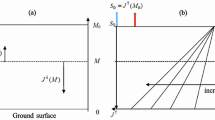Abstract
Changes in the Earth’s atmosphere that affect its energetics are analyzed. The results of NASA programs on carbon dioxide monitoring in the atmosphere and the evolution of the global temperature, as well as data on measurements of the evolution of local temperature in the past, are presented. Global power processes are analyzed on the basi of contemporary information both for: natural processes and those resulting from human activity. The channels of establishment of an equilibrium between the change in the mass of atmospheric carbon dioxide and that in global temperature are considered. They include decrease of the total rate of photosynthesis as a result of deforestation, combustion of fossil fuels and the greenhouse effect. Based on current information, it is shown that none of these channels explains the observed accumulation of carbon dioxide in the atmosphere. The inconsistency of climatological models of changes in the global temperature as a result of an increase in the concentration of carbon dioxide, which are the basis of the Paris Agreements on Climate, has been demonstrated. The use of these models is based on the assumption that the spectra of carbon dioxide and water molecules do not overlap, which contradicts both the data resulting from measurements with NASA programs and calculations based on the spectroscopic parameters of molecules from the HITRAN data bank. The Pauling concept, which is based on the thermodynamic equilibrium between free atmospheric CO2 molecules in the atmosphere and bound carbon at the Earth’s surface, is presented. Based on this concept, the different nature of the past and current equilibrium is shown. Thus, in the past, the slowest process of oxidation of the bound carbon at the Earth’s surface was the evaporation of carbon dioxide molecules dissolved in the ocean, while the limiting process at present is oxidation of carbonates in the oceans.










Similar content being viewed by others
REFERENCES
Trends in Atmospheric Carbon Dioxide. Global Monitoring Laboratory. http://www.esrl.noaa.gov/gmd/ ccgg/trends/.
Conners, D., Scientists calculate a new rate for global photosynthesis, EarthSky, 2011. https://earthsky.org/earth/scientists-calculate-a-new-rate-for-global-photosynthesis.
Joos, F. and Spahni, R., Proc. Natl. Acad. Sci. U. S. A., 2008, vol. 105, p. 1425.
Le Quere, C., Andrew, R.M., Friedlingstein, P., et al., Earth Syst. Sci. Data, 2018, vol. 10, p. 2141.
Hausfather, Z., Analysis: Fossil-fuel emissions in 2018 increasing at fastest rate for seven years, Carbon Brief 2018. http://www.carbonbrief.org/analysis-fossil-fuel-emissions-in-2018-increasing-at-fastest-rate-for-seven-years.
Runyan, C. and D’Odorico, P., Global Deforestation, Cambridge: Cambridge Univ. Press, 2016.
Nunez, Ch., Deforestation, National Geographic, 2019. http://www.nationalgeographic.com/environment/global-warming/deforestation/.
Forest Area. The World Bank. https://data.worldbank.org/indicator/ag.lnd.frst.zs.
Efficiency of Photosynthesis. https://ru.wikipedia.org/wiki/Effektivnost’_fotosinteza.
Blankenship, R.E., Tiede, D.M., Barber, J., et al., Science, 2011, vol. 332, p. 805.
Hansen, J.E., Johnson, D., Lacis, A., et al., Science, 1981, vol. 213, p. 957.
Rohde, R., Global Temperature Report for 2018. Berkley Earth, 2019. http://berkeleyearth.org/2018-temperatures/.
Global Climate Report, May 2018, National Centers for Environmental Information. http://www.ncdc. noaa.gov/sotc/global/201805.
Global Climate Report, May 2019, National Centers for Environmental Information. http://www.ncdc. noaa.gov/sotc/global/201905.
Lüthi, D., Le Floch, M., Bereiter, B., et al., Nature, 2008, vol. 453, p. 379.
Mauna Loa Observatory. https://en.wikipedia.org/wiki/Mauna_Loa_Observatory.
Smirnov, B.M., Fizika global’noi atmosfery (Physics of the Global Atmosphere), Dolgoprudnyi: Intellekt, 2017.
Smirnov, B.M., Infrakrasnoe izluchenie v energetike atmosfery, High Temp., 2019, vol. 57, no. 4, p. 573.
Smirnov, B.M., Infrared Atmospheric Spectroscopy, Berlin: DeGruyter, 2020.
Smirnov, B.M., Microphysics of Atmospheric Phenomena, Sham: Springer, 2017.
Smirnov, B.M., J. Phys. D: Appl. Phys., 2018, vol. 51, 214004.
Krainov, V. and Smirnov, B.M., Atomic and Molecular Radiative Processes, Sham: Springer, 2019.
Climate Sensitivity. https://en.wikipedia.org/wiki/Climate_sensitivity.
Climate Change 2013: The Physical Science Basis. Contribution of Working Group I to the Fifth Assessment Report of the Intergovernmental Panel on Climate Change, Stocker, T.F., Qin, D., Plattner, G.-K., et al., Eds., Cambridge: Cambridge Univ. Press, 2018. www.ipcc.ch/site/assets/uploads/2018/02/WG1AR5_ all_final.pdf.
Arrhenius, S., London Edinburgh Philos. Mag. J. Sci., 1896, vol. 41, p. 237.
Plass, G.N., Tellus, 1956, vol. 3, p. 140.
Carbon Cycle. https://en.wikipedia.org/wiki/Carbon_cycle.
Pauling, L., General Chemistry, San Francisco: Freeman, 1970.
Kauffman, J.M., J. Sci. Explor., 2007, vol. 4, p. 723.
Svensmark, H. and Friis-Christensen, E., J. Atmos. Terr. Phys., 1997, vol. 59, p. 1225.
Svensmark, H., Proc. R. Soc. London, Ser. A, 2007, vol. 463, p. 385.
Svensmark, H., Bondo, T., and Svensmark, J., Geophys. Rev. Lett., 2009, vol. 36, L151001.
Svensmark, H., Englo, M.B., and Pedersen, J.O.P., Phys. Lett. A, 2013, vol. A377, p. 2343.
Milankovich, M., Canon of Insolation and the Ice Age Problem, Belgrade: Agency for Textbooks, 1998.
HITRAN. https://hitran.iao.ru/home.
HITRAN Online. https://hitran.org/links/.
Author information
Authors and Affiliations
Corresponding author
Additional information
Translated by V. Selikhanovich
Rights and permissions
About this article
Cite this article
Smirnov, B.M. Problems in Global Atmospheric Energetics of the Atmosphere. High Temp 59, 207–218 (2021). https://doi.org/10.1134/S0018151X21030123
Received:
Revised:
Accepted:
Published:
Issue Date:
DOI: https://doi.org/10.1134/S0018151X21030123



